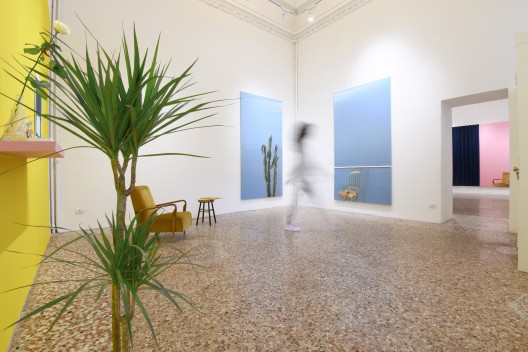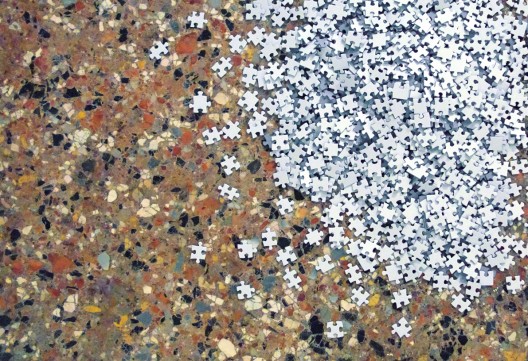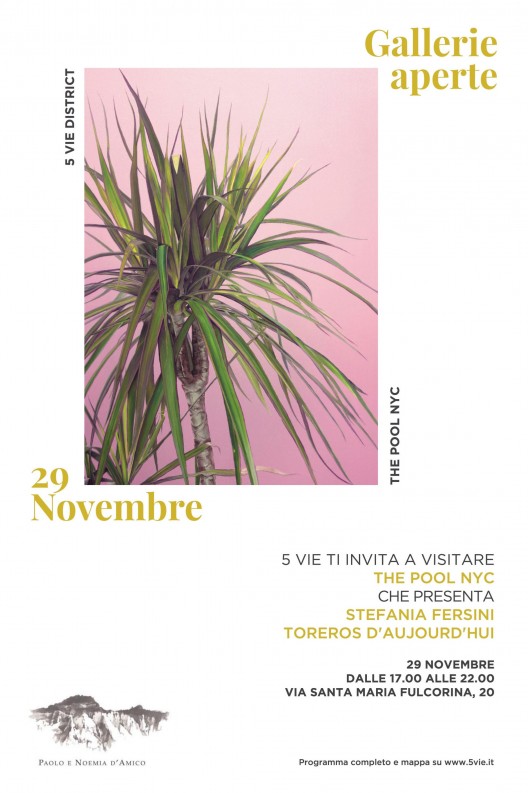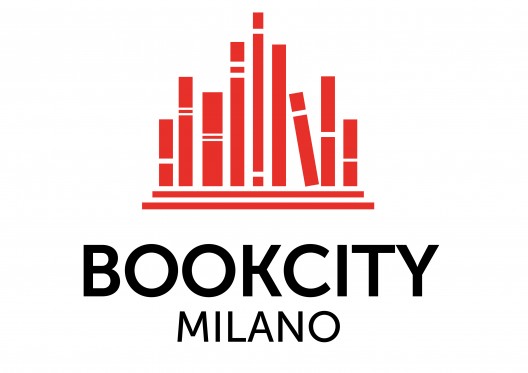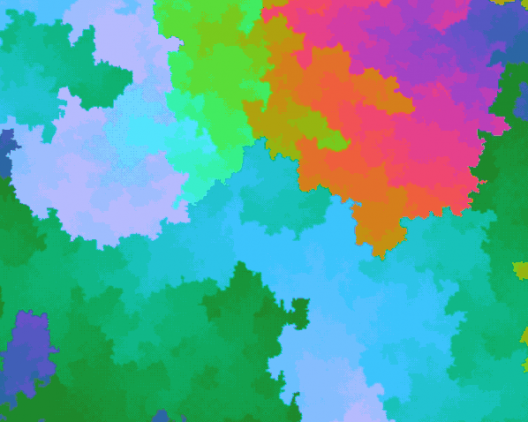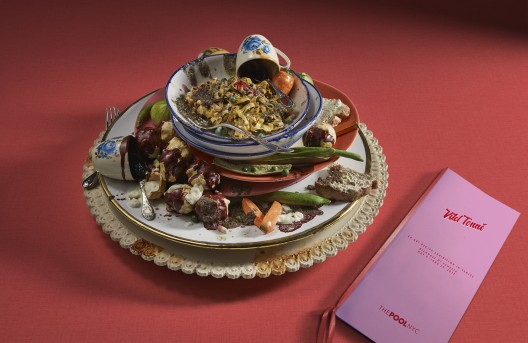Search Results for 'STEFANIA FERSINI'
11 November- 21 December
The world is full of objects, more or less interesting; I do not wish to add any more.
I prefer, simply, to state the existence of things in terms of time and/or space.
Douglas Huebler
In Palazzo Fagnani Ronzoni, THE POOL NYC presents Toreros d’Aujourd’hui, Stefania Fersini’s first solo exhibition in Milan. Describing Stefania Fersini’s (Aosta, 1982) brave meta-artistic and post-curatorial work, is an act of equal critical and narrative braveness. However, this young artist has already demonstrated an extreme elusive pictorial quality, playing with the enigma of recognition – of herself, of others – and with real and imaginary space conceptions. Mansions and historical palaces transformed with works as Mirror (Casa Mollino, Turin) and Vanitas (Palazzo Reale, Milan), are just two out of many examples.
For this particular installation – special, for every ascent is determined by growing risk – Fersini puts into effect her mimesis with the exhibition space, a slight repetition of the artist in others’s masterpieces; a process of fragmentation of herself in other artists works; a scenographer and editor awareness; a theatrical direction of an absent work.
In fact, Toreros d’aujourd’hui transforms Palazzo Fagnani Ronzoni, THE POOL NYC gallery’s exhibition site, in the same work presented by Fersini. A place that becomes etymologically domestic, home of pastel colours and innovative materials; a space that gets to a continuous déjà vu of partially and peripherally painted curtains and tapestries, with fictitious furnishings and paintings, playing in between expectations and reality, background and subject.
Actually, the “house” created by the artist is made of many works – both old and new, because time is a factor to keep in mind at every step in the labyrinthine reasoning – by Aldo Mondino, Hilario Isola and Gabetti and Isola: Fersini is omnipresent, working at the same time as a frame and a container for the above-mentioned works, suddenly revealing herself while keeping her typical elusivity. The subject represented in this work is connected to the work itself while being located in a different place. The subject, chosen by Fersini, is not in front of the canvas that could represent it, yet – maybe – in another room. The space between the object and its representation, the aesthetics of the observer’s deception by an omniscient and ironic narrator: the experience of the exhibition is in itself the work – indeed, the meta-work. Finally, this experience is intimately connected to the biography of the artists, in a continuous genealogical exchange between preceptors and successors; a genetic and hereditary relationship – Hilario Isola, as a matter of fact, plays his father’s intellectual legacy with his Aristotele. The exhibition’s name itself comes from a book by Aldo Mondino, specifically chosen for this occasion by her son Antonio.
With some clue-phrases from other authors – embroidered and painted with his calligraphy – Fersini calls out fathers and sons to an artistic and genetic dialogue of memes, in a framework made out of memories and references between space and time, guaranteeing extraordinary powers of wondering, attraction, inquiry and universality.
Federica Maria Giallombardo
Il mondo è pieno di oggetti, più o meno interessanti; non voglio aggiungerne altri. Preferisco, semplicemente, affermare l’esistenza delle cose in termini di tempo e/o spazio.
Douglas Huebler
Nelle sale di Palazzo Fagnani Ronzoni THE POOL NYC presenta Toreros d’Aujourd’hui, la prima mostra personale di Stefania Fersini a Milano. Descrivere l’audace impresa meta-artistica e post-curatoriale di Stefania Fersini (Aosta, 1982) è un atto di altrettanta arditezza critica e narrativa. Del resto, la giovane artista già ha dimostrato una qualità pittorica elusiva estrema, che gioca con l’enigma del riconoscimento – di sé, degli altri – e della concezione dello spazio reale e immaginario – si pensi alle dimore e ai palazzi storici trasformati grazie a opere come Mirror (Casa Mollino, Torino) e Vanitas (Palazzo Reale, Milano).
Per questa singolare installazione – particolare, perché ogni ascesa è determinata da un rischio maggiore – Fersini attua la sua mimesi con lo spazio espositivo in senso stretto: un ripetersi sottile in ogni capolavoro altrui; una frammentazione di sé negli altri; una consapevolezza da scenografa e curatrice; una regia teatrale di un’opera assente, plasmata di vuoti quanto di quotidiani. Infatti, Toreros d’aujourd’hui trasforma Palazzo Fagnani Ronzoni, sede espositiva della galleria THE POOL NYC, nella stessa unica opera di Fersini presentata. Un luogo che diventa etimologicamente domestico, alcova di tinte pastello ed elementi riconoscibili; uno spazio che diviene un perpetuo déjà vu di tende e tappezzerie dipinte parzialmente e in maniera periferica, con mobili e quadri fittizi, che gioca sull’ambivalenza di aspettativa e realtà, sfondo e soggetto, margine e protagonismo. Effettivamente, la “casa” ideata dall’artista è composta da alcuni lavori – vecchi e nuovi, e il fattore tempo è da tenere presente a ogni passo nel labirintico ragionamento – di Aldo Mondino, Hilario Isola e Gabetti e Isola: Fersini è onnipresente, facendo da cornice e da contenitore delle opere dei suddetti, svelandosi a tratti e ricreando la costante elusività che la rappresenta. Ciò che viene rappresentato sull’opera sarà un oggetto legato all’opera stessa e dislocato in spazi diversi. L’oggetto, selezionato da Fersini, non si troverà davanti alla tela che lo potrebbe raffigurare, ma in un’altra stanza. La ricerca, nello spazio, dell’armonia dell’esposizione e della riflessione; lo scampolo tra l’opera reale e quella riprodotta; l’estetica dello scacco dell’osservatore da parte di una narratrice onnisciente e ironica: l’esperienza della mostra è di per sé l’opera – anzi, la meta-opera.
Si aggiunga infine che l’esperienza è intimamente connessa a quella biografica degli artisti, in un continuo scambio genealogico tra precettori e successori; una relazione genetica e artisticamente ereditaria – Hilario Isola, ad esempio, interpreta il lascito intellettuale del padre con il suo Aristotele. Persino il titolo della mostra deriva dal nome di un libro appartenuto ad Aldo Mondino, appositamente scelto da suo figlio Antonio per questa occasione. Con le frasi-indizi di altri autori – ricamate e dipinte con la sua calligrafia – Fersini invita padri e figli a un dialogo artistico e genetico di memi, in un teatro di ricordi e rimandi tra spazio e tempo, garantendo straordinari poteri di meraviglia, attrazione, interrogazione e universalità.
Federica Maria Giallombardo
On the occasion of the 15th Architecture Biennale, THE POOL NYC is coming back to Venice with Show on Show, a solo exhibition by Stefania Fersini.
The show will run from 25th May through 27th November and it will take place at Palazzo Cesari-Marchesi, located in the Calle Rombiasio in Campo Santa Maria del Giglio adjacent to Piazza San Marco.
Stefania Fersini’s intervention will happen in a space with historical connotations, following the installations at Casa Mollino and Casa Fornasetti. The XVIII Century palace bears the signs of a range of architectural and decorative additions reflecting different times. Abandoned for 30 years the palace is now stripped and walking through it one can perceive a great past.
Show on show presents the place in its own place, generating a temporal perceptive and cognitive loop. It is a silent action to let space and time talk.
The artist has created for THE POOL NYC a work requesting the viewer’s participation.
Stefania Fersini scatters in the halls of the palace ten puzzles laid on recovered furniture. The visitor, finding empty seats, is invited ‘to play the game’, combining tile after tile of still unknown images.
The representation is exactly what the eyes can see while looking at the puzzle, but there are two main differences compared to reality: the first one is the temporal character, as the puzzle is still a messy pile of cards; the second one is the content: the tiles represent nothing, are white, without a subject.
Fersini’s site specific installation could be considered as a tautological gesture for the inherent desire to reveal on the puzzle what the eye can see during the composition of the puzzle itself. It involves the viewer’s interaction and in order to build the puzzle, she does not provide the resulting image, but the reality itself that is represented in the work. The “player” will find a fragmented reality broken in his hands. It’s a mise an abyme that needs to be defined and confirmed.
The subjects are perceived as matter in its details: colors, portions of the
pavement, walls, and wood.
The artist plays with our perception and let us reflect whether reality comes first than representation.
Fersini’s work questions time, which alludes to a becoming, at times perceived as ‘destroying’, in other as ‘creating’.
She expresses her critical relationship with the destroyed image, and asks the viewer to engage in the creation of the work.
The puzzle execution emulates the painting practice, chosen by the artist.
It’s her choice, and for herself.
‘We need time to solve problems and it’s our own time that leads us to the knowledge’.
Her cognitive research focuses again on a missing content.
Following Mirrors at Museo Casa Mollino and Casa Fornasetti, the artist’s use of the white states a missing visual work, to fill that void.
Fersini adds another piece to her journey, waiting to see if the road has taken the lead sooner or later to fill that white piece.
Stefania Fersini (1982) is an Italian artist.
She studied Product Design (faculty of Architecture) and she became part of Nucleo, a collective of artists and designers, based in Torino, Italy. Her designs have been exhibited worldwide over the past years and in the most important art and design fairs such as Design Miami, Artissima, PAD, and many more.
In 2012 she started a personal artistic project.
After a creative crisis Fersini became attracted to the meditative aspect of painting’s execution (precipitated by “The Anxiety of Influence” by Harold Bloom, philosopher Gilles Deleuze, and the studies of Lacan specifically relating to the pleasure principle by means of repetition).
Her last exhibitions include a solo show at Museo Casa Mollino, Torino and at Casa Fornasetti, Milano.
Her artwork has been exhibited extensively around the world. Important institutions such as Fondazione Sandretto Re Rebaudengo, Torino, Fondazione Querini Stampalia, Venezia, Casa Museo Boschi, Milano and selected galleries in Torino, Lucca, Milano, Los Angeles, London, Paris, Koln, New York and San Francisco have featured Fersini’s work.
Recently, she has been examining the context in which art is displayed and the exhibition itself as a medium.
This is the first solo exhibition with THE POOL NYC.
On the occasion of the 15th Architecture Biennale, the art gallery THE POOL NYC is coming back to Venice with Show on Show, a solo exhibition by Stefania Fersini.
The show will run from 25th May through 27th November and it will take place at Palazzo Cesari-Marchesi, located in the Calle Rombiasio in Campo Santa Maria del Giglio adjacent to Piazza San Marco.
Stefania Fersinis intervention will happen in a space with historical connotations, following the installations at Casa Mollino and Casa Fornasetti.
The XVIII Century palace bears the signs of a range of architectural and decorative additions reflecting different times. Abandoned for 30 years the palace is now stripped and walking through it one can perceive a great past.
Show on show presents the place in its own place, generating a temporal perceptive and cognitive loop. It is a silent action to let space and time talk.
The artist has created for THE POOL NYC a work requesting the viewer’s participation.
Stefania Fersini scatters in the halls of the palace ten puzzles laid on recovered furniture. The visitor, finding empty seats, is invited to play the game, combining tile after tile of still unknown images.
The representation is exactly what the eyes can see while looking at the puzzle, but there are two main differences compared to reality: the first one is the temporal character, as the puzzle is still a messy pile of cards; the second one is the content: the tiles represent nothing, are white, without a subject.
Fersinis site specific installation could be considered as a tautological gesture for the inherent desire to reveal on the puzzle what the eye can see during the composition of the puzzle itself. It involves the viewers interaction and in order to build the puzzle, she does not provide the resulting image, but the reality itself that is represented in the work. The “player” will find a fragmented reality broken in his hands. Its a mise an abyme that needs to be defined and confirmed.
The subjects are perceived as matter in its details: colors, portions of the pavement, walls, and wood.
The artist plays with our perception and let us reflect whether reality comes first than representation.
Fersinis work questions time, which alludes to a becoming, at times perceived as destroying, in other as creating.
She expresses her critical relationship with the destroyed image, and asks the viewer to engage in the creation of the work.
The puzzle execution emulates the painting practice, chosen by the artist.
Its her choice, and for herself.
We need time to solve problems and its our own time that leads us to the knowledge.
Her cognitive research focuses again on a missing content.
Following Mirrors at Museo Casa Mollino and Casa Fornasetti, the artists use of the white states a missing visual work, to fill that void.
Fersini adds another piece to her journey, waiting to see if the road has taken the lead sooner or later to fill that white piece.
Stefania Fersini (1982) is an Italian artist.
She studied Product Design (faculty of Architecture) and she became part of Nucleo, a collective of artists and designers, based in Torino, Italy. Her designs have been exhibited worldwide over the past years and in the most important art and design fairs.
In 2012 she started a personal artistic project.
After a creative crisis Fersini became attracted to the meditative aspect of paintings execution (precipitated by The Anxiety of Influence by Harold Bloom, philosopher Gilles Deleuze, and the studies of Lacan specifically relating to the pleasure principle by means of repetition).
Her last exhibitions include a solo show at Casa Mollino, Torino and at Casa Fornasetti, Milano.
Her artwork has been exhibited extensively in Torino, Lucca, Milano, Los Angeles, London, Paris, Koln, New York and San Francisco.
Recently, she has been examining the context in which art is displayed and the exhibition itself as a medium.
This is the first solo exhibition with THE POOL NYC.
The preview will take place on 25th May from 6 to 9 pm.
Address: Calle Rombiasio, Campo Santa Maria del Giglio, 30124 Venezia.
How to find us: Once in Campo Santa Maria del Giglio, walk opposite to Canal Grande, pass the church of Santa Maria del Giglio on the left and Tessitura Bevilacqua on the right, following THE POOL NYC stickers.
Vaporetto stop: S. Maria del Giglio (same stop of the Gritti Palace) Line 1
Water access: Rio de lAlboro (aka Rio de le Ostreghe)
Dates: 25th May-27th November 2016
Hours of Operation: from May 25 to June 12 daily 11 am 7 pm. From June 13 to November 27 by appointment only.
Giovedì 29 Novembre nel quartiere delle 5 Vie di Milano, le gallerie d’arte rimarranno aperte fino alle 22.
In occasione dell’apertura straordinaria, durante la mostra personale “Toreros d’Aujourd’hui” di Stefania Fersini, la galleria THE POOL NYC ospita il curatore Maurizio Bortolotti con un talk sull’arte contemporanea in Cina.
Vi Aspettiamo a Palazzo Fagnani Ronzoni, in Via Santa Maria Fulcorina, 20.
Gli scaffali interiori – vedersi vedere. Arte visiva e incursioni letterarie
Domenica 18 Novembre 2018 alle 18.30 presso THE POOL NYC
Con Gianluigi Ricuperati, Federica Giallombardo e Stefania Fersini
Negli spazi della galleria THE POOL NYC, Ricuperati e Giallombardo parleranno di arte contemporanea alla presenza dell’artista Stefania Fersini e verrà illustrato il libro “Inner Shelf”.
Sarà possibile visitare la mostra personale di Fersini e confrontarsi con l’artista e la curatrice Viola Romoli.
#BCM18
SEMPRE colore, dagli albori dell’arte ai giorni nostri.
In Costante Colore i lavori in mostra sono un inno al colore, sono la materia pittorica sfaccettata secondo l’espressione di ogni singolo artista.
Ci concentriamo sulla declinazione dell’uso del colore per evidenziarne l’importanza e la costanza nel mondo dell’arte senza badar al tema o al medium del lavoro mostrato.
Il colore in vetro, in ceramica, in pastello, in neon, a penna, ad acquerello, a pennarello, in acrilico, ad olio, in video. Il colore acceso, tenue, metallico, primario, artificiale, naturale, complementare.
Il colore è materia, è odore, ingombro.
Il colore è vita.
Il colore suscita emozioni forti, tensione, ossessione, erotismo, azione, densità, gioia, euforia, lacerazione, movimento, dolore, desiderio, passione, imprevisto, possibilità, opzione, equilibrio, entropia, fisicità, trasfigurazione, proporzione, coerenza.
Il colore è la costante: l’unica grandezza che rimane invariata al variare delle grandezze con cui è in relazione. Per cui il colore non varia al variare dei media con cui è in relazione e dei secoli che passano.
Il colore esiste da secoli e continuerà a cangiare perché è qualcosa di imprescindibile e di caratteristico nell’arte: agisce da sempre con la medesima intensità.
La declinazione del colore avviene seguendo tempi e media diversi.
Nel Medioevo il colore doveva essere brillante e intenso, applicato con una forte saturazione, senza sfumature, per sottolineare il significato simbolico. Nel luogo divino il colore rivelava la presenza di Dio: i colori sono il frutto dell’interazione fra luce e oscurità.
Dal Duecento il colore che simboleggiava il più alto grado di nobiltà era il blu, metafora di spiritualità e trascendenza. Nella pittura murale il blu veniva usato per gli sfondi ed era realizzato con la tinta densa ottenuta dalla polvere dei preziosi lapislazzuli. Nella Certosa di Pavia il lapislazzuli utilizzato da Bergognone per l’Incoronazione di Maria tra Francesco Sforza e Ludovico il Moro appare ancora oggi di uno straordinario e lucente azzurro.
Il colore evolve, cambia, diventa caldo, fluorescente, diventa neon, diventa non colore.
Il bianco e il nero acquistano una grande importanza nella Storia dell’Arte.
Il colore fa chiarezza con l’Impressionismo, non si ferma con DaDa, illumina il Secessionismo, trionfa con la Pop-Art, degenera con l’Espressionismo, si sfoga con l’Astrattismo, si placa con il Minimalismo, soffre nell’Arte Povera, si stabilizza con la Transavanguardia. I movimenti artistici si susseguono, i secoli passano, il colore arde sempre.
Quando la televisione diventa a colori, l’immagine si accende, tutto prende vita e si illumina.
Il colore è esploso in tv, ma nell’arte vive da tempo: non c’è una tendenza che detta l’uso del colore. Nella moda c’è il colore dell’anno, ma non nell’arte, dove qualsiasi tonalità si può usare e con qualsiasi nuance si può osare.
Ci sono colori che erano impensabili qualche decennio fa. I colori risentono dell’atmosfera che c’è in quel dato momento storico e politico. I gusti si adeguano al pensiero del tempo.
C’è un senso cromatico che regna sovrano in ogni epoca. Senso cromatico inteso come una idoneità di colori uniti.
Il colore è sfinimento, è impressione, ridondanza, esasperazione, sofferenza, disagio, follia, esagerazione, sensibilità, estenuazione, tradizione, apparenza, sostanza, interiorità, espressione, maniacalità, immediatezza, riflessione, spontaneità, gestualità, ritmo, fuoco, caldo, freddo, insofferenza, magia, sogno, ricorrenza, spasmo, soffio, sessualità, intransigenza, zelo, solerzia, energia, assiduità, fastidio, bellezza. Il colore è naturalmente creatività, genialità, inventiva.
Always Colour, from the dawn of art till today.
In Costante Colore (Constant: Colour) the works on display are an ode to colour, the pictorial substance that is declined according to the expression of each artist.
We focus on the way of using the colour in order to highlight the importance and the constancy in the world of art regardless the subject or the medium of the work on exhibit.
The colour on glass, on ceramics, crayon, neon light, in pen and wash drawings, in acrylics, in oil paintings and videos. Bright, soft, metallic, primary, artificial, natural, complementary colour.
Colour is matter, scent, space.
Colour is life.
Colour arouses strong emotions such as tension, obsession, eroticism, action, joy, life, euphoria, rupture, movement, pain, desire, passion, surprise, chance, option, balance, entropy, physicality, transfiguration, proportion, coherence.
Colour is the mathematical constant: it is the only value that remains unchanged when the elements with which it is related change. Thus the colour does not change according either to the media with which it is related or to the centuries that pass by.
Colour has existed for centuries and will keep changing because it is part of the nature of art itself: it acts today, as it has always acted, with the same intensity.
The declination of colour follows different patterns of time and medium.
In the Middle Age, colours had to be bright and intense, applied with strong colour saturation, without nuances, in order to underline its symbolism. In the sacred place the colour revealed the presence of God: colours are the result of the interaction between light and darkness.
From the 13th century the colour symbolizing the highest nobility was blue, a metaphor of spirituality and transcendence. In the Certosa of Pavia the lapis lazuli used by Bergognone for the Coronation of Mary between Francesco Sforza and Ludovico il Moro still appears today an extraordinary and shining blue.
The colour evolves, changes, becomes warmer, more fluorescent, becomes neon light, becomes non-colour.
Black and white gain significance in Art History.
Colour becomes clarity with Impressionism, does not stop with DaDa, shines in Secessionism, triumphs with Pop-Art, degenerates with Expressionism, erupts with Abstractism, subsides with Minimalism, suffers in the Arte Povera, stabilizes with Transavanguardia. The artistic movements evolve, the centuries pass by, the colour keeps burning.
When the television develops colour, the image lights up, everything comes to life and lights up.
Colours exploded in TV, but lived for a long time in art. There is no trend that sets the standard for the use of colour.
In fashion each year has a colour, but art has not, and any shade can be used and with any nuance can be dared.
There are colours that were unthinkable a few decades ago. The colours are affected by the atmosphere in a particular historical and political moment. Tastes adjust to the spirit of the period.
A specific chromatic sense dominates every age. Chromatic sense means a balance of united colours.
The colour is exhaustion, impression, redundancy, exasperation, suffering, discomfort, madness, exaggeration, sensitivity, extenuation, tradition, appearance, substance, interiority, expression, mania, immediacy, reflection, spontaneity, gesture, rhythm, fire, warmth, cold, intolerance, magic, dream, recurrence, spasm, puff, sexuality, intransigence, zeal, alacrity, energy, assiduity, annoyance, beauty. Colour is naturally creativity, genius.
Artists:
Federico Solmi, Bertozzi & Casoni, Jonathan Rider, Stefania Fersini, Andrea Salvatori, Giuseppe Stampone, Patrick Jacobs, Francesco Mori, James Case-Leal, Joseph Kosuth, Aldo Mondino, Giulio Turcato, Gina Beavers, Eteri Chkadua, Bianca Sforni, Ercole Barovier, Fulvio Bianconi, Carlo Scarpa, Vinicio Vianello, Matteo Vinti.
Primo Dicembre 2017 – 16 Febbraio 2018
Vernissage: 30 Novembre 2017
Orario: Martedì-Venerdì, 11-13 / 15-19
Sabato: 15-19
December 1st 2017 – February 16th 2018
Opening Reception: November 30, 6-10 pm
Hours: Tuesday-Friday 2-7 pm
THE POOL NYC
Palazzo Fagnani
Via Santa Maria Fulcorina, 20
20123 Milano
An Art Recipe Exhibition in Venice
THE POOL NYC at Palazzo Cesari-Marchesi
Calle Rombiasio 2539,
Campo Santa Maria del Giglio, Venezia
MAY 9-JUNE 25 2017
Vitel Tonné is a Piedmontese dish of cold, sliced veal covered with a creamy, mayonnaise-like sauce that has been flavored with tuna; it is also known as “the main course of an Italian meal or as an exceedingly elegant antipasto for an elaborate dinner”, Marcella Hazan, the famous authority on Italian cuisine, states.
Veal + tuna + mayonnaise, separately strong ingredients, with solid flavour, compose a great dish. According to canonical parameters on cooking, Vitel tonné should not exist, Fish + Meat = Forbidden! And if it did not, Italian cuisine would be sorely lacking.
But, there is always an exception, and it’s the peculiar nature that gives birth to a genius dish.
This culinary introduction, might sound like an odd premise for an art show, but it is only too appropriate for the organic exhibition that THE POOL NYC is presenting for this 2017 Venice Biennale at Palazzo Cesari-Marchesi.
We are proud to serve a selection of junk media and free range artists, very spicy and from various countries, all belonging to the same kitchen of ART.
Art, as we see it, is the Grande Cucina with many chefs, all with their own unique sense of personality, humor, fantasy, intelligence, sensitivity.
There is a common denominator that let arts stick together, even being from different centuries and origins, as it happens in magical recipes.
THE POOL NYC is happy to marinate, in the rooms of an old Venetian Palace of the XVIII century, a wide selection of Modern and Contemporary artworks for a digestible show.
Walking through the salons of the palazzo will entertain your eyes, will stimulate your spirit, and will nourish your cultural avidity. Every room is filled with a specific medium in order to satiate your need of ceramic, figurative painting, or photography without additives. Your artistic hunger will be satisfied by slicing every single work of art installed within the Palazzo.
The Menu is rich of interesting dishes, made of contemporary dairy free ceramic, organic paintings of the XX and XXI Century served in an old building.
This explosive dressing will regenerate your stomach. It will be a shake of artworks, to savor all together, or each separately. You can start with a vegan antipasto of photography and end with a glazed ceramic dessert.
The main salon, garnished with stuccos, hosts a convivial long table, where the whole art family, will peacefully dine, exchanging opinions despite their different nature.
In Italy we experience the Cuisine not just as a survival or Epicurean moment, but as a situation where we get together. We don’t care about nationality, dairy products, color, vegetarianism, taste, Extra Virgin Olive Oil, size, veganism, age, medium, political views, feminism, spacialism, abstract art, pop-art, we can live together and devour it all.
This is a gluttonous experience, and we are pleased to share it with you.
Il Vitel Tonné è un piatto tipico piemontese realizzato con il girello di vitello e la salsa tonnata. Si può guarnire con capperi e limone.
Vitello, tonno e maionese, ognuno con un sapore forte, danno vita a una ricetta favolosa.
Seguendo i canonici parametri della buona Cucina, il Vitel Tonné non dovrebbe esistere perché Carne + Pesce = Divieto Assoluto! Ma ecco l’eccezione che conferma la regola.
Questa introduzione culinaria potrebbe apparire bizzarra per una mostra d’arte, ma è assolutamente adatta per la organic exhibition che THE POOL NYC presenta a Palazzo Cesari-Marchesi in occasione della 57esima edizione de La Biennale di Venezia.
Acquolina in bocca per i più avidi collezionisti. Si tratta di una mostra ghiotta: vetri, ceramica, pittura, astratta e figurativa, video, installazioni, fotografia, disegni, acquerelli, diorami; una visione dell’arte come esperienza golosa, adatta a palati sopraffini.
Siamo orgogliosi di servirvi una selezione di junk media e artisti liberi, assai speziati e di varia provenienza, tutti però appartenenti alla stessa Cucina dell’Arte.
L’arte, per come la intendiamo, è la Grande Cucina con tanti cuochi, ognuno con la propria personalità, humor, fantasia, intelligenza e sensibilità.
Un comune denominatore fa sì che le arti, sebbene di secoli e luoghi diversi, ben convivano, proprio come nelle migliori ricette di cucina.
Nelle stanze di un antico palazzo veneziano del XVIII secolo, THE POOL NYC è felice di marinare un’ampia selezione di lavori di Arte Moderna e Contemporanea per una mostra davvero sfiziosa.
Camminare all’interno dei saloni del palazzo attrarrà i vostri occhi, stimolerà lo spirito e nutrirà la vostra avidità culturale. Ogni stanza è farcita d’arte per saziare il vostro bisogno di installazioni multimediali, di pittura figurativa, o di diorami senza conservanti.
Questo menu esplosivo vi rigenererà. Potrete cominciare con un antipasto di fotografia e finire con una spuma di ceramica invetriata.
La sala principale, guarnita con stucchi, ospita un banchetto dove l’intera famiglia dell’arte mangerà insieme, scambiando convivialmente opinioni.
In Italia siamo abituati a mangiare non tanto per sopravvivere o per il piacere del palato, ma soprattutto per stare insieme, come atto simposiaco. Non importa la nazionalità dei partecipanti, la loro età, il colore, l’appartenenza a una corrente artistica, che siano vegetariani, figurativi, o biodinamici; non discriminiamo nessuno per le visioni politiche o i media utilizzati; siamo aperti al Femminismo, allo Spazialismo, all’Astrattismo, alla Pop-Art; usiamo Olio Extra Vergine d’Oliva e acrilico; ci ritroviamo tutti insieme allegramente e divoriamo tutto quel che ci viene proposto.
Preparatevi a un’esperienza golosa, che noi siamo felici di condividere con voi.
Artists:
Ercole Barovier, Gina Beavers, Bertozzi & Casoni, Giacomo Cappellin, James Case-Leal, Eteri Chkadua, Marcel Dzama, Giorgio Ferro, Stefania Fersini, Piero Fogliati, Luigi Ghirri, Piero Gilardi, Giorgio Griffa, Riccardo Guarneri, Patrick Jacobs, Austin Lee, Sol LeWitt, Aldo Mondino, Niccolò Montesi, MVM, Luigi Ontani, Jonathan Rider, Andrea Salvatori, Antonio Scaccabarozzi, Carlo Scarpa, Peter Schuyff, Archimede Seguso, Bianca Sforni, Federico Solmi, Giuseppe Stampone, Fratelli Toso, Giulio Turcato, Ludwig Wilding.
Address:
Calle Rombiasio, Campo Santa Maria del Giglio, 30124 Venezia.
How to find us:
Once in Campo Santa Maria del Giglio, walk opposite to Canal Grande, pass the church of Santa Maria del Giglio on the left and Tessitura Bevilacqua on the right, following THE POOL NYC stickers.
Vaporetto stop: S. Maria del Giglio (same stop of the Gritti Palace)
Water access: Rio de l’Alboro (aka Rio de le Ostreghe)
Hours of Operation: daily 11 am – 7 pm and by appointment
Vernissage and Opening Reception: 9th May 2017 at 6 pm.
#thepoolnyc
#viteltonnevenezia
A special Thanks to Scaramouche NY for their collaboration

